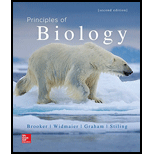
Introduction:
Animal life has evolved in hundreds of millions of years on Earth. Some scientists claim that changing environmental conditions, like the accumulation of dissolved oxygen and ocean minerals or increased atmospheric oxygen, eventually allowed higher
Answer to Problem 1TY
The correct answer is option (e)bilateria, protostomia, ecdysozoa.
Explanation of Solution
Explanation/justification for the correct answer:
Option (e) Bilateria, Protostomia, Ecdysozoa.The correct hierarchy of divisions in the animal kingdom from most inclusive to least inclusive is Bilateria, Protostomia, Ecdysozoa. All animals are believed to be derived from a choanoflagellate-like ancestor. An animal categorized based on body plans and molecular data. So, the correct answer is option (e).
Explanation for incorrect answer:
Option (a)Deuterostomia, Protostomia, Ecdysozoa. The correct hierarchy of divisions in the animal kingdom from most inclusive to least inclusive is Bilateria, Protostomia, Ecdysozoa. All animals are believed to be derived from a choanoflagellate-like ancestor. An animal categorized based on body plans and molecular data. Thus, from most inclusive and least inclusive Deuterostomia, Protostomia, Ecdysozoa is not the correct hierarchy of divisions in the animal kingdom. So, this is an incorrect option.
Option (b) Bilateria, Lophotrochozoa, Deuterostomia.The correct hierarchy of divisions in the animal kingdom from most inclusive to least inclusive is Bilateria, Protostomia, Ecdysozoa. All animals are believed to be derived from a choanoflagellate-like ancestor. An animal is categorized based on body plans and molecular data. Thus, from most inclusive and least inclusive, Bilateria, Lophotrochozoa, Deuterostomia is not the correct hierarchy of divisions in the animal kingdom. So, this is an incorrect option.
Option (c)Bilateria, Ecdysozoa, Protostomia.The correct hierarchy of divisions in the animal kingdom, from most inclusive to least inclusive is Bilateria, Protostomia, Ecdysozoa. All animals are believed to be derived from a choanoflagellate-like ancestor. An animal categorized based on body plans and molecular data. Thus, from most inclusive and least inclusive, Bilateria, Ecdysozoa, Protostomiais not the correct hierarchy of divisions in the animal kingdom. So, this is an incorrect option.
Option (d)Deuterostomia, Ecdysozoa, Bilateria.The correct hierarchy of divisions in the animal kingdom, from most inclusive to least inclusive is Bilateria, Protostomia, Ecdysozoa. All animals are believed to be derived from a choanoflagellate-like ancestor. An animal categorized based on body plans and molecular data. Thus, from most inclusive and least inclusive, Deuterostomia, Ecdysozoa, Bilateriais not the correct hierarchy of divisions in the animal kingdom. So, this is an incorrect option.
Want to see more full solutions like this?
Chapter 26 Solutions
Principles of Biology
- Can you described the image? Can you explain the question as well their answer and how to get to an answer to an problem like this?arrow_forwardglg 112 mid unit assignment Identifying melting processesarrow_forwardGive only the mode of inheritance consistent with all three pedigrees and only two reasons that support this, nothing more, (it shouldn't take too long)arrow_forward
- Oarrow_forwardDescribe the principle of homeostasis.arrow_forwardExplain how the hormones of the glands listed below travel around the body to target organs and tissues : Pituitary gland Hypothalamus Thyroid Parathyroid Adrenal Pineal Pancreas(islets of langerhans) Gonads (testes and ovaries) Placentaarrow_forward
- What are the functions of the hormones produced in the glands listed below: Pituitary gland Hypothalamus Thyroid Parathyroid Adrenal Pineal Pancreas(islets of langerhans) Gonads (testes and ovaries) Placentaarrow_forwardDescribe the hormones produced in the glands listed below: Pituitary gland Hypothalamus Thyroid Parathyroid Adrenal Pineal Pancreas(islets of langerhans) Gonads (testes and ovaries) Placentaarrow_forwardPlease help me calculate drug dosage from the following information: Patient weight: 35 pounds, so 15.9 kilograms (got this by dividing 35 pounds by 2.2 kilograms) Drug dose: 0.05mg/kg Drug concentration: 2mg/mLarrow_forward
- A 25-year-old woman presents to the emergency department with a 2-day history of fever, chills, severe headache, and confusion. She recently returned from a trip to sub-Saharan Africa, where she did not take malaria prophylaxis. On examination, she is febrile (39.8°C/103.6°F) and hypotensive. Laboratory studies reveal hemoglobin of 8.0 g/dL, platelet count of 50,000/μL, and evidence of hemoglobinuria. A peripheral blood smear shows ring forms and banana-shaped gametocytes. Which of the following Plasmodium species is most likely responsible for her severe symptoms? A. Plasmodium vivax B. Plasmodium ovale C. Plasmodium malariae D. Plasmodium falciparumarrow_forwardStandard Concentration (caffeine) mg/L Absorbance Reading 10 0.322 20 0.697 40 1.535 60 2.520 80 3.100arrow_forwardPlease draw in the missing answer, thank youarrow_forward
 Concepts of BiologyBiologyISBN:9781938168116Author:Samantha Fowler, Rebecca Roush, James WisePublisher:OpenStax College
Concepts of BiologyBiologyISBN:9781938168116Author:Samantha Fowler, Rebecca Roush, James WisePublisher:OpenStax College Biology: The Dynamic Science (MindTap Course List)BiologyISBN:9781305389892Author:Peter J. Russell, Paul E. Hertz, Beverly McMillanPublisher:Cengage Learning
Biology: The Dynamic Science (MindTap Course List)BiologyISBN:9781305389892Author:Peter J. Russell, Paul E. Hertz, Beverly McMillanPublisher:Cengage Learning Biology 2eBiologyISBN:9781947172517Author:Matthew Douglas, Jung Choi, Mary Ann ClarkPublisher:OpenStax
Biology 2eBiologyISBN:9781947172517Author:Matthew Douglas, Jung Choi, Mary Ann ClarkPublisher:OpenStax Biology Today and Tomorrow without Physiology (Mi...BiologyISBN:9781305117396Author:Cecie Starr, Christine Evers, Lisa StarrPublisher:Cengage Learning
Biology Today and Tomorrow without Physiology (Mi...BiologyISBN:9781305117396Author:Cecie Starr, Christine Evers, Lisa StarrPublisher:Cengage Learning
 Biology: The Unity and Diversity of Life (MindTap...BiologyISBN:9781305073951Author:Cecie Starr, Ralph Taggart, Christine Evers, Lisa StarrPublisher:Cengage Learning
Biology: The Unity and Diversity of Life (MindTap...BiologyISBN:9781305073951Author:Cecie Starr, Ralph Taggart, Christine Evers, Lisa StarrPublisher:Cengage Learning





